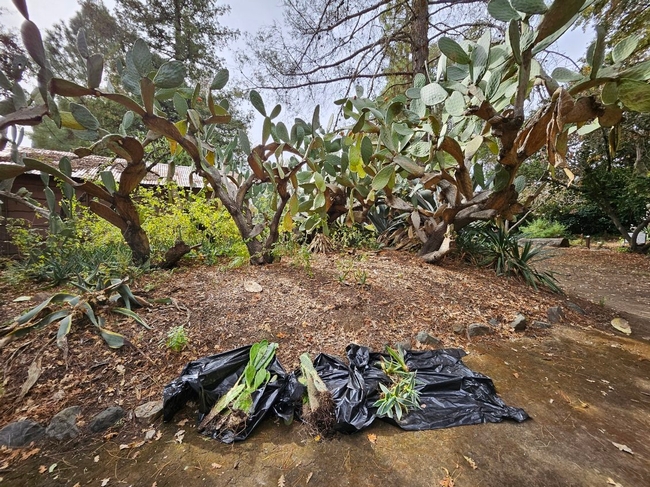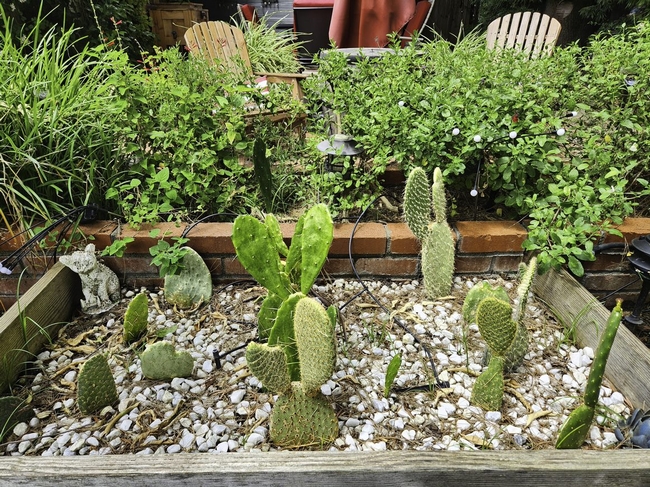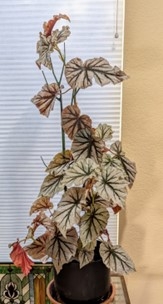- Author: Erin Mahaney
As winter begins, it provides an opportunity to assess what is working in the garden and what isn't, including whether and how plants should be pruned, moved, or removed. Now that many plants have lost their leaves or are dormant, it is easier to assess potential edits to the garden. Right now, I'm considering whether to move or remove two Ugni molinae, otherwise known as Chilean Guava or Strawberry Myrtle.
A few years ago, on impulse I purchased two Chilean Guava plants at a local nursery. I was charmed by the description of a “highly ornamental” edible fruiting shrub with delicious red berries that could be made into jam. Supposedly, it was Queen Victoria's favorite fruit! The plant is easily pruned and requires low water. It seemed perfect for a specific location in my yard. The nursery description said that the plant may not set fruit alone, so two plants should be planted together. I was a little less thrilled by having to find room for two plants, but I decided to give them a try.
The Chilean Guava is quite pretty and useful in the right location. It has small dark green leaves on upright branches that serve as attractive filler for bouquets. It produces tiny, beautiful, bell-shaped, pale pink to white flowers followed by small pink-red fruits. The flowers and berries are so small, however, that they are not very noticeable unless the plant is located where it can be observed from close proximity. The flowers are described as fragrant, but I haven't found the fragrance to be particularly noticeable. The Chilean Guava grows from 1-6' tall and 1-3' wide and can be pruned to any size in that range. It would make a good informal hedge, although my plants tend to flop over once they reach about 4' tall. It requires part shade to full sun and low water.
I don't know if it is my plants or Queen Victoria's tastebuds, but the berries have not lived up to their description. My plants have not fruited very well, and when they do, it is challenging to catch the berries at peak ripeness because they are easily overlooked. Perhaps I haven't picked them at exactly the right time, but the flavor is underwhelming. I am rather wistful about the exotic jam I will not be making.
So now I have two plants that have benefits and drawbacks. They have lovely foliage, are easy to prune, are pest-free, and are drought tolerant. But they are not as upright as described, and I have to tie them up each summer so they don't flop over other plants. The flowers and berries are not what I had expected. Even though the plants receive the recommended amount of sun, I have wondered if they would do better in an even sunnier part of the garden. But my garden is small,l and moving the plants would mean removing other plants. I also have subsequently learned that the plants are self-fertile and pollinated by bees, which means that I didn't have to purchase two of them.
I am not making a decision today, but this is the challenge of having a small garden. Leave a plant that is adequate and has some benefits or make room for something potentially better?
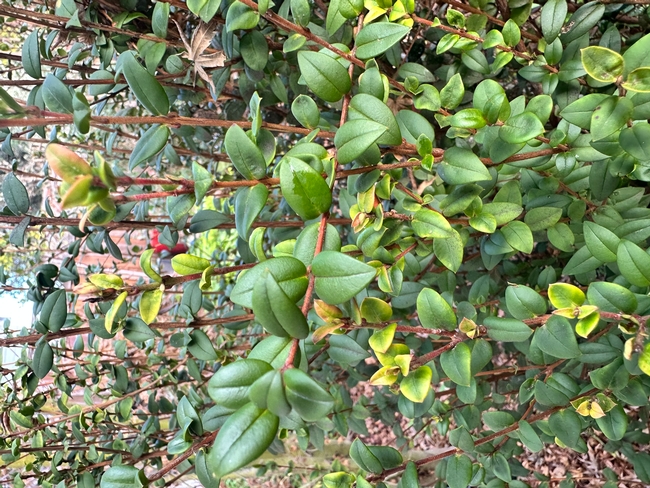
- Author: Michelle Schlegel
For years I thought this tree at our seasonal pond, was a Brazilian pepper (Schinus terebinthifolia). Finally, I decided to look more closely into its identity. A Brazilian pepper is, of course, one of the topmost invasive species, mostly where there is plenty of water, like Florida and Texas. But it has made its way to a few parts of California. Locally, on the Calflora website, UC Davis identified a Brazilian pepper in northwest Vacaville.
The Brazilian peppers leaves, bark and peppers contain Monoterpenes, other similar chemicals and Urushiol. Sitting under that tree can cause respiratory congestion, chest pains, sneezing and flu-like symptoms. Touching the plant can cause skin irritations like poison oak, ivy, or poison sumac. The leaves will also give off a turpentine smell when crushed.
My kids played near this tree at their fort and trampoline for years without problems. We have also cut back young trees that have spread, burned them in our burn piles and none of us have ever experienced any medical complications. So, what could this tree be?
My neighbor, who has lived here for 55 years, told me that this used to be the only tree like it for miles around. He did say that goats used to graze this land and would eat all the pepper berries they could get. That would have helped keep the tree more contained. We moved here over 20 years ago. The goats no longer are here to eat, just occasional birds eat the peppers.
The Brazilian pepper and Mt. Atlas Mastic tree have nearly the same leaf structure and bark. It is difficult to tell them apart.
The Brazilian Pepper fruit/peppers stay red. The Mastic trees' berries turn from red to blue when fully ripe. The Brazilian Pepper typically has 5-7 leaflets, while the Mastic has 9-11 leaflets.
Since there are NO toxic effects from touching any parts of this mystery tree or burning the wood, and the berries DO turn red to blue, we can safely assume its identity is a Mt. Atlas Mastic tree. It is good that I do not have an invasive Brazilian pepper, but Mt. Atlas Mastic trees are also considered invasive!
Mt. Atlas Mastic trees were brought to California as a rootstock for Pistacia vera, the Pistachio tree. The Mastic tree was also introduced here as an ornamental, shade-bearing, drought-tolerant landscape tree. Sadly, because of the berries, this tree escaped cultivation to become invasive also.
We have lived here for over 20 years now, and have gone from having the ONLY TREE to now seeing hundreds along roadsides, fence lines and under power lines. How in the world did this tree spread like this? Answer: Meet the European Starling!
European Starling- Matt Davis/Macaulay Library, Cornell Labs
The European Starling was brought to Central Park in New York City in 1890. Forty-mated pairs of these birds were released. Their population has increased to an estimated 200 million nationwide. They are aggressive and compete with native birds for nesting sites. The Starlings also cause an estimated 800 million dollars damage to agricultural crops. Lastly, their droppings spread infectious diseases to people and livestock. Starlings have been named as the top 100 worst invaders in the world.
In the fall to early winter, we have flocks of Starlings who fly into this tree by the hundreds and strip as many berries as they can eat. They swoop away just as suddenly as they came in. These birds stop on fences, powerlines, and in taller trees. In a year or two, we can see where the Starlings have stopped and dropped some of the berries. More and more seedlings are popping up everywhere. It's rather funny that my invasive tree is being spread for miles by an invasive bird!
On a happier note, have you ever seen huge flocks of Starlings flying together? These birds gather in huge flocks in the fall and early winter. They fly as a “shapeshifting ball” that moves in waves up and down, shifting back and around. It's a phenomenon called “murmuration”. We have amazing Starling murmurations here in the States to see, but Europe, and especially the UK, really has the best murmuration shows.
Sources:
Brazilian Pepper, Schinus terebinthifolia-
USDA, National Invasive Species Database
Calflora-invasive plants in California
Global Invasive Species Database: Cuda, J. P., A. P. Ferriter, V. Manrique, and J.C. Medal, (Editors) 2006. J.P. Cuda, Brazilian Peppertree Task Force Chair. Interagency Brazilian Peppertree (Schinus terebinthifolius) Management Plan for Florida 2nd Edition.
Missouri Botanical Garden.org
Cal-ipc.org
Sources:
Mt. Atlas Mastic, Pistacia atlantica-
Calflora- observation search
University of Arizona Campus Arboretum
iNaturalist
Sources:
European Starling-
Cornell Labs -All about Birds
University of Nebraska-European Starlings
Birdfact- Starling murmurations
Invasive Species List of California
- Author: Jenni Dodini


- Author: Paula Pashby
In June, 2024, I wrote a blog about a magnificent old Prickly Pear Opuntia basilaris cactus garden located in the Peña Adobe Regional Park, just west of Vacaville, CA https://ucanr.edu/blogs/blogcore/postdetail.cfm?postnum=60014. In the blog, I wrote about my fellow Master Gardeners and I weeding the cactus garden and cleaning it up to bring it back to its glory.
While weeding the cactus garden, we found around a half dozen pieces on the ground. We thought about planting them back in the garden. However, the cactus garden at Pena Adobe does not have a steady water source, and no rain was expected for a period. So, I brought the cactus pieces home to plant in my garden, hoping they would grow new roots and survive with daily care.
Well, they not only survived the move, but they also flourished and came into their own as beautiful juvenile cactus plants! The cactus transplants were doing so well that they quickly outgrew the area where I had planted them in my garden. Now that they were healthy, I returned them to the original Peña Adobe cactus garden.
My husband and I gently dug up the cactus plants from our home garden and discovered a healthy growth of roots. We carefully replanted them back at the Peña Adobe cactus garden and watered them well from some jugs we brought. I periodically returned to water the transplants and gave them the TLC they needed.
I always became attached to the plants in my garden, but I kept the mindset that these cactus transplants were just in temporary foster care. So, I am very pleased that they are now back home and thriving next to their 60-year-old ancestors.
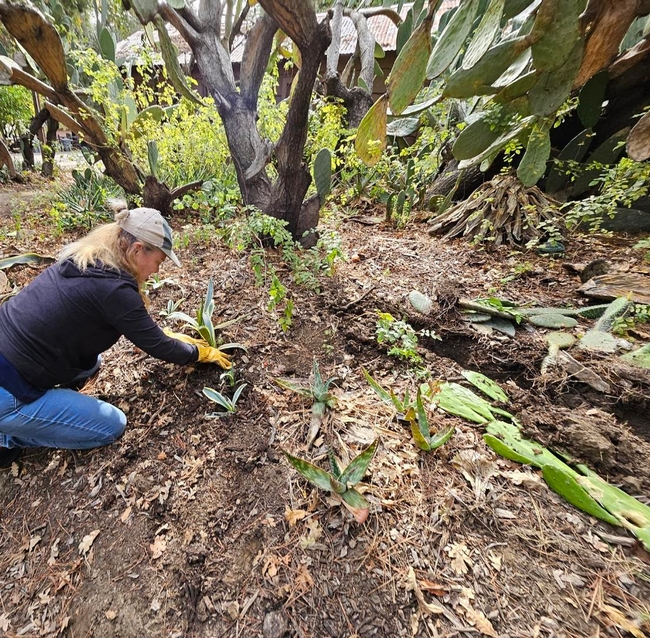
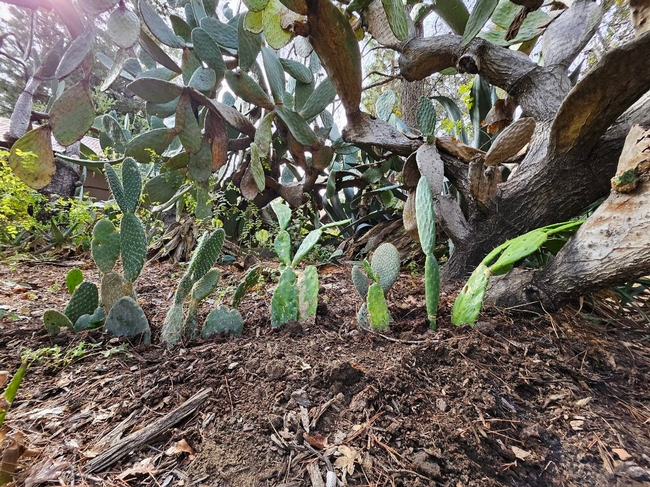
- Author: Michelle Krespi
As gardeners, we know that we have failures and sadly wind up sometimes killing a plant we love. Such was the case with my Begonia rex. It lived for several years outdoors in a spot that had indirect light. At first, it thrived, but then it began to deteriorate. I moved to Fairfield and placed my plant inside next to the window, where it got indirect light, but sadly, it just deteriorated from there. Finally, I called it quits, cut the plant down to soil level, and left it like that for a time. As it turns out, I could not help myself and kept watering the soil in the hope that something might happen. After all, what was the harm other than wasting a little water? This went on for months until one day to my surprise and delight, just like magic the plant began to show signs of life. I kept on watering and fertilizing and wound up with a plant that looks like this in its new permanent home![1]
Begonia rex, commonly known as King Begonia or Painted-Leaf begonia, is a species of flowering perennial plant in the family Begoniaceace. It was found in southeast China and was then introduced to Bangladesh, Cuba, and Hispaniola (the most populous island in the West Indies.) It is the parent to over 500 cultivars, with many cultivars earning the Royal Horticultural Society's Award of Garden Merit. Fortunately, the care and maintenance for all cultivars are the same! As I discovered through trial and error, Begonia rex thrives in bright, indirect light[2] since the leaves will burn in excessive direct sunlight. It prefers to be planted in well-draining soil, thriving in a mixture of clay, sand, and loam. It also responds well to a mixture of potting soil mixed with peat moss and perlite. Drainage, drainage, drainage! Keep in mind that you can detect a potting mix that is too heavy if the water pools on the soil surface.
Rex begonia does best at 50% humidity. If you do not have a humidifier, put the plant on a shallow tray filled with pebbles and fill it with water up to the top of the pebbles, making sure the water does not touch the bottom of the pot. Some varieties of begonia go dormant in winter, requiring reduced watering until spring when new growth returns. The tricks to watering are to ensure the top two inches of soil are always moist while ensuring your plant is not sitting in excessive water. One of the most common plant disease Begonias are susceptible to is root rot which comes from overwatering. In fact, for beginner gardeners, overwatering your plants is the number one mistake we make! Another helpful tip for watering any of your plants is to let the water sit in a container for 24 hours before using which will allow for the contaminants to evaporate causing less stress for your plants.[3] It also allows for your water to be room temperature, which most plants prefer.
King begonias are known for their large, variegated leaves. My begonia has leaves up to nine inches long and five inches wide, and interestingly enough, the leaves were even larger the second time around, which demonstrates the benefits of hard (aggressive) pruning. Finally, Rex Begonias need a steady supply of nutrients to flourish. They prefer a balanced fertilizer (the macro ingredients, N-P-K) nitrogen, phosphorus, and potassium all have the same number as 10-10-10. Organic fertilizers such as compost or worm casting offer slow-release fertilization and will improve soil quality over time.[4]
I have so enjoyed my begonia because of its vivid colors, it is hearty nature and its ease of care. So much so I am designating a corner of a room just for them! Just like Lazarus of Bethany, my plant miraculously came back to life, but this time with much more vigor![5]
[1] Website Garden Guides
[2] Wikipedia- Begonia rex
[3] Website- plantophiles.com
[4] Website- livetoplant.com
[5] Picture of plant, top right was taken by the author of her own plant!









